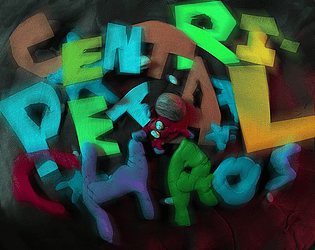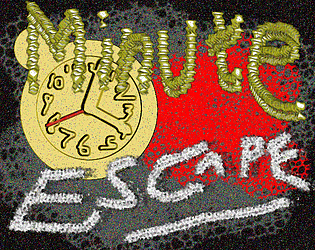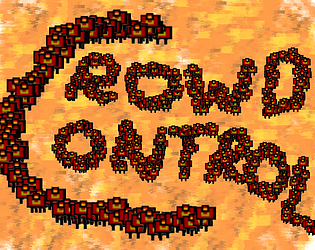Love the general concept of buying upgrades to make your code more inefficient. The red screen signaled the endtimes, but I do kind of wish the game started chugging as you got nearer and nearer to the end.
jermrellum
Creator of
Recent community posts
This is one of the most enjoyable games I've played in the jam so far. Love to see the Outer Wilds influence (which is probably my favorite game) with how the player accumulates knowledge to progress quicker. I did kinda guess the password after only getting two letters, but I felt like at that point I had solved the major puzzles anyway.
Absolutely loved this. A brainvania! I've wanted to do one myself but they just seem so difficult (especially in a full game context where the player might accidentally learn a technique on their own -- at least here that's unlikely to happen). Still, you have to be clever enough to make the ideas natural to have them intuitive, but not intuitive enough for the player to stumble upon. It's a hard balance, so I'm very impressed that it was found here. This is my favorite game of the jam so far, even more than the Sisyphus becomes a live-streamer game and the Sisyphus discovers <spoiler>cat videos</spoiler> game. I've wishlisted your game as well.
I've only played like 2 or 3 other brainvanias (Toki Tori 2, The Witness, arguably Outer Wilds) so playing more is a blast. I feel like this and the meta-sokoban (Corrypt, the end of Baba is You) are my favorite micro-genres.
idk what's wrong with me, I can't stop playing Sisyphus games. Actually, I like this one the best so far because rolling the boulder is a matter of skill, and it feels like your fault when it starts rolling back down, but the physics system makes it chaotic so the boulder can go over your head, at which point you're scrambling back to retrieve the rock in a Getting Over It kind of way. Also, another subtle design bit that I like is that the boulder's surface isn't uniformly round, which makes it a constantly dynamic challenge as you're rolling it uphill.
EDIT: Yee
What's weird about these jams is how similar themes will show up in completely different games, and in this jam, I keep seeing futility. There are several Sisyphean games in the vein where the player can't even win, which is a relatively uncommon thing to do and now I've been seeing it all over this jam. So when I got to level 12, I see that yet again: try and you will fail. (unless you CAN beat level 12, idk).
This helped btw, I think I made the width too big somehow (looking back at the code, I didn't divide by 2; fixed it here) because I overshot it and reopened the game 15 times, and when I tried to fix it, it double clicked a pixel and deleted everything. This took like two hours to run as well, so I don't really feel like trying again.
import java.awt.Robot;
import java.awt.event.InputEvent;
public class Main
{
public static void main(String[] args)
{
try
{
Robot rob = new Robot();
int startX = 780;
int startY = 271;
int width = 362;
int height = 540;
int secondsBeforeStarting = 3;
rob.delay(secondsBeforeStarting * 1000);
for(var i=0; i<width/2; i++)
{
for(var j=0; j<height/2; j++)
{
rob.mouseMove(startX+i*2, startY+j*2);
rob.mousePress(InputEvent.BUTTON1_MASK);
rob.delay(50);
rob.mouseRelease(InputEvent.BUTTON1_MASK);
rob.delay(50);
}
}
}
catch(Exception e)
{
}
}
}This is my favorite game I've played in the jam so far (of about 50). Recursion is fun and causes existential dread.
I like how:
1. Jumping outside the bounds just puts you into the next highest world, and your size grows back to normal. There is no escape.
2. The angle of objects doesn't move as you turn, which lets you place them easier -- though it can still be a little difficult to place them exactly how you want. I got the board by placing the bridge on the castle tower and then interacting with it in mid-air as I jumped, which I feel like wasn't the intended way since everything was so delicate.
Despite my control problems (web version was unplayable because the mouse wasn't being locked, initially even figuring out how the wheels were supposed to be interacted with was a struggle, then every time I tried to climb off the roof of the mech I'd fall all the way to the ground, and staying on top of the cannon was a challenge) I found this immensely enjoyable, collecting 8/8 in 27:43. I assume that's the end of the game at least, because the timer stopped. The shader makes it look great too -- definitely wish for sound effects, but this looks like it took all of the 4 days already.
So I'm def someone who loves first person cameras more than third, but in the case where literally the point of the game is to eat to make yourself bigger, I feel like the third person camera should have at least been the default -- I didn't even understand what was happening until I already won, then I went back and played again and decided to press "C". That being said, the style is great; it looks awesome.
See, this is the exact kind of brutalist aesthetic that I actually love; the same kind of low poly, trippy space that a game like Cruelty Squad inhabits. It'd be even better with sound effects. But yeah, if it weren't for the style, it's kind of a wonky shooter with really floaty movement, but honestly the floaty movement feels part of the charm.
This is one of these ideas that's so simple and so clever that it's the kind of thing I wish I could figure out when I'm thinking up an idea for the theme. How do you even conceive of this game concept in your head and then even know it will work? Maybe I'm approaching this from a top-down design approach when it's more about a process of discovery.
One neat subtle bit of design that I love here is that it's a Sokoban-type puzzler in a sense, but the player is indistinguishable from the items they're pushing. When you yourself are an element to the solution (ie which "boulders" are placed where, and you're also one of those boulders), it adds an extra layer of depth to the puzzles.
Anyway, some levels are really clever, but some levels can be really chaotic in trying to predict what numbers will appear where. The latter feel less satisfying because they can be a bit "fiddle to win".
But overall I think the game is really clever and a great idea that I never would've thought of. It fuses Sokoban and Minesweeper together great and keeps both of their mechanics.
So I like the idea but is there a secret to the controls? I swear sometimes the arrow doesn't appear, other times when I release nothing happens, and then I click again and the arrow moves to my current position and I have to start again. The game seems difficult enough without the controls bogging me down, and from what I've seen so far it seems pretty competent otherwise.
How is this so polished? There are only a few levels, but that's understandable in a game jam. I'm simply astonished by the graphical quality and the fact that the AI actually functions (there have been a few other games where you place objects to guide players (both in 2D even) and they're way more jank). It feels like a demo to a full game practically. Perfect score.
Oh boy did I love this. I love how it's both an action and a puzzler, I love how it manages to still feel like Snake mechanically but with Sokoban mechanics added on top of that, and I love how from a pretty simple ruleset comes pretty complicated results. There are a lot of cool levels in here too; it's most satisfying when the puzzle has the simplest elements (least artifice) yet is surprisingly hard.
I think this is my favorite game in the jam (and only my second perfect score in 150 games that I've played). Love the idea of it being (essentially) a reverse Metroidvania. It's a fun puzzler that requires you to think and keep track of where everything is and what you need to get where. I probably would've have been a lot more confused if I hadn't read the description underneath with all the icons (I mean who reads the instructions right?), which was really helpful in explaining specifically what the glove did, what the bow was for, and what could destroy what.
overall good job
Edit: I also want to add that I had a lot of trouble coming up with a game idea for this theme (though I usually take at least 5 hours to start doing anything, this year I didn't start doing anything until 9 hours in). I didn't like how it felt like all I could do was take an existing game and reverse it (what if Metal Gear Solid but you're the guard?; what if Frogger but you run over frogs?; what if fishing but you're the fish?; what if Pac-Man but you're the ghost? -- and there are games in this jam that do all of those, probably much better than I would).
So I was expecting like, half the games in this jam to be Sokoban-based puzzlers where you move the map around instead of the player (because that's what I did), yet after 140ish games, this is the first one I played. I mean, I assume there are like a ton more, but honestly this game is probably all I need because it's really great.
I especially like the orientation based mechanics -- you can pick up a sword but it needs to be facing the correct direction for you to be able to use it. And then later I really like when lava gets involved as a stationary element because A) it gives you a frame of reference, B) because it adds a lot of great new mechanics. Actually, this has quite a lot of mechanics packed into it's 16 levels.
Loved it. My initial reaction to the tutorial box moving instead of the player was a moment. My only issue comes from the awkwardness of the controls -- how you have to completely stop in order to switch controls, and how awkward it can be sometimes to get around. Don't know how you'd get around that either though.
There's a Cthulhu-like horror to this -- you've managed to play a game where you play as the monster and it still manages to be scary. You have a mild drone and an unrelatable entity that you can never really get a clear good look at that's chasing down a human that's much like yourself. As a result, it feels like you're hunting yourself, like it's inevitable that death will catch you.
kinda like a Tarkovsky film but with a Juice WRLD soundtrack
This was strangely a lot more enjoyable than I anticipated from the first few seconds. At first I thought it was a straight gag game -- you die immediately because you're a level 1 goblin and that's the joke. I was curious to see if I could run away from the player so I ran and hid over in the room the player came from, and fell into the void.
I was about to quit when I realized that the paladina actually had a health bar, and my allies were actually doing considerable damage. Not enough to win in the end without my help, but enough to make me realize that this was an achievable goal.
On restart, I noticed the game world was much larger than I thought. Plenty of places to run at least, and the paladina actually does get distracted instead of mercilessly hunting you down.
Difficulty is a tough thing to balance. If the paladina was too easy to defeat, this game would be pointless and boring. Too difficult, and this would be impossible and frustrating. Worse, that balance will be different for each player, and because the game is supposed to be difficult, a difficulty selector doesn't really work here. For me, the balance was great.
You had to learn a route, know where to run and when, how long to throw barrels for, etc. With your only attacks being a jank throwing mechanic, you have to rely on your allies, but they're limited and can only do so much for you. Ultimately, you have to manage both in tandem.
If you do fall in the basement too early, you're pretty much toast -- you'd think you could've put in like a real staircase instead of two weird white floating rectangles.
Idk, I'm a fan of jank 1 hit kill super hard games like "I Wanna Be the Guy" so this appealed to me.
So I imagine if you had more time you might've done these things but:
- When the gun fires, there should be some kind of visual feedback to the player besides the audio
- A brief tutorial (that is skipped on resets) where you pick up a bullet, load it into a gun, and fire it (it's a great mechanic, but because it's unusual, players might wonder why their gun isn't working)
I thought this was pretty cool though. Took me like 5 minutes before I could manage to even hit one of the eyes (they're fast movers), but after I managed to do it once, I was more easily able to replicate it, and so then a few minutes later I got 'em all and triggered the ending.
















